
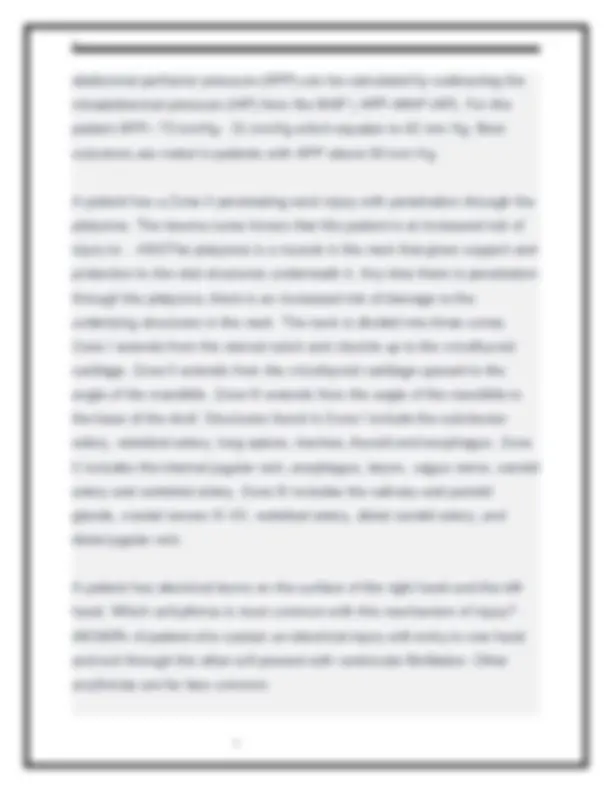
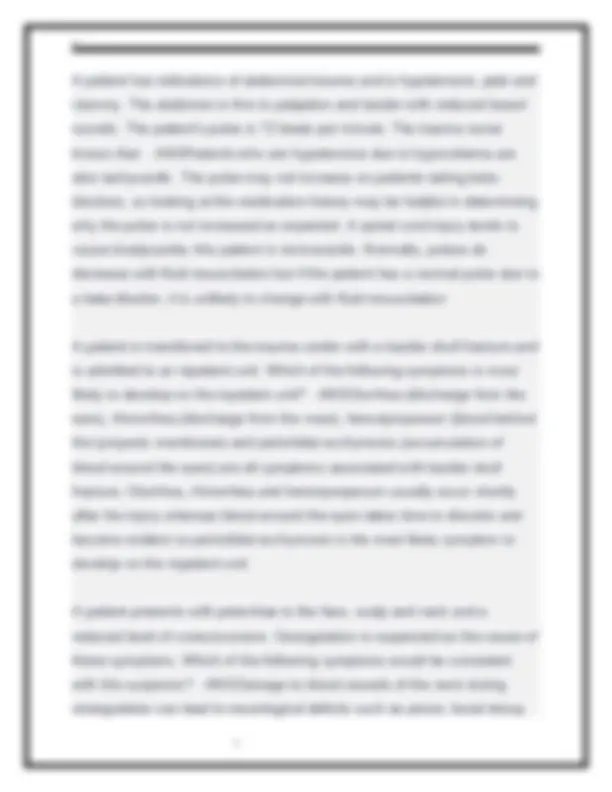
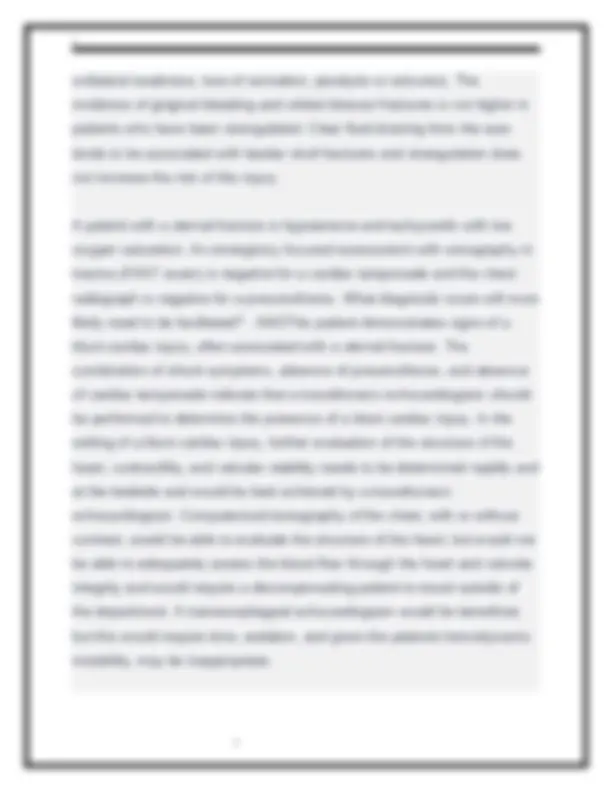
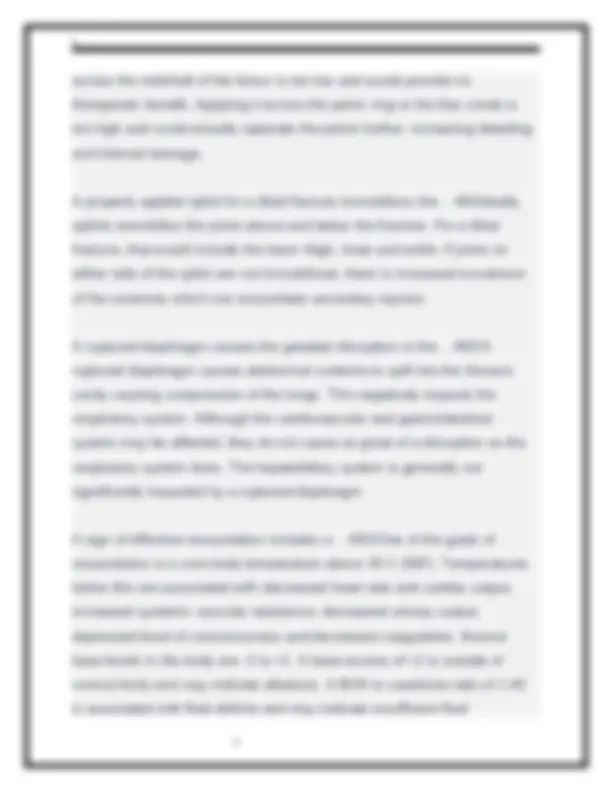
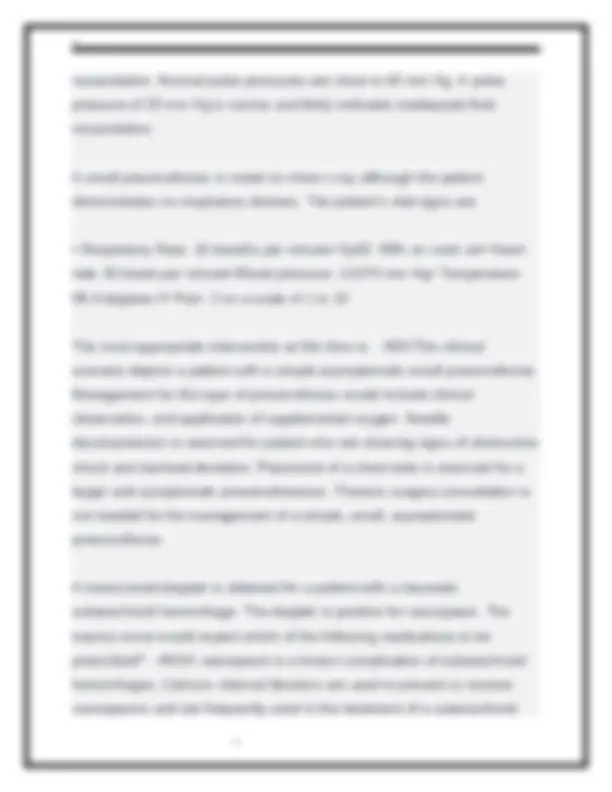
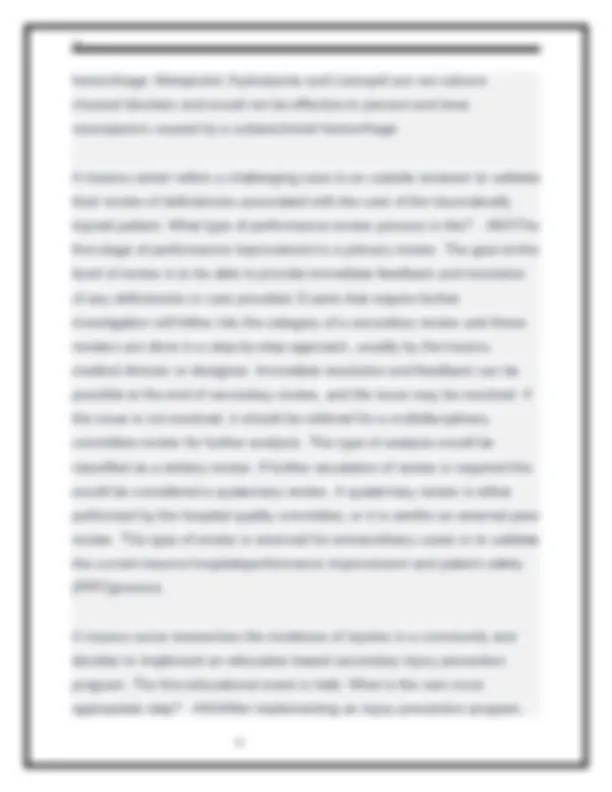
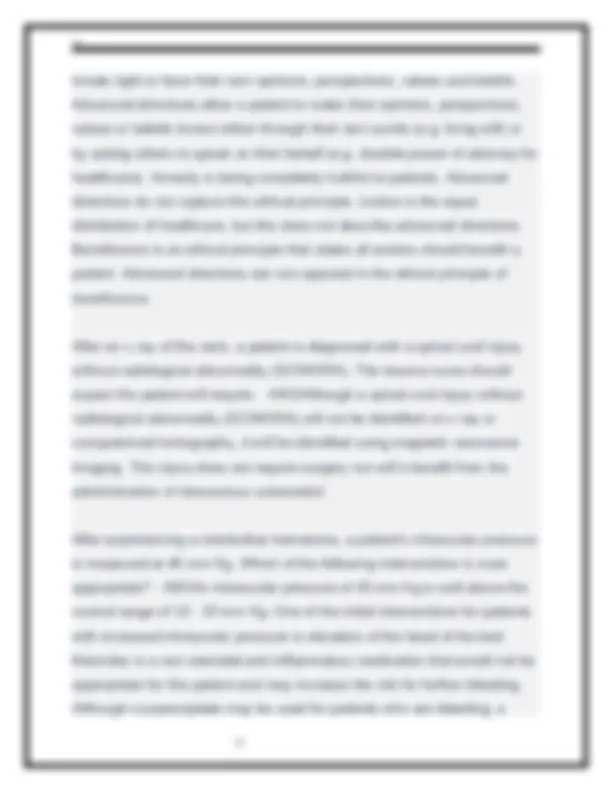
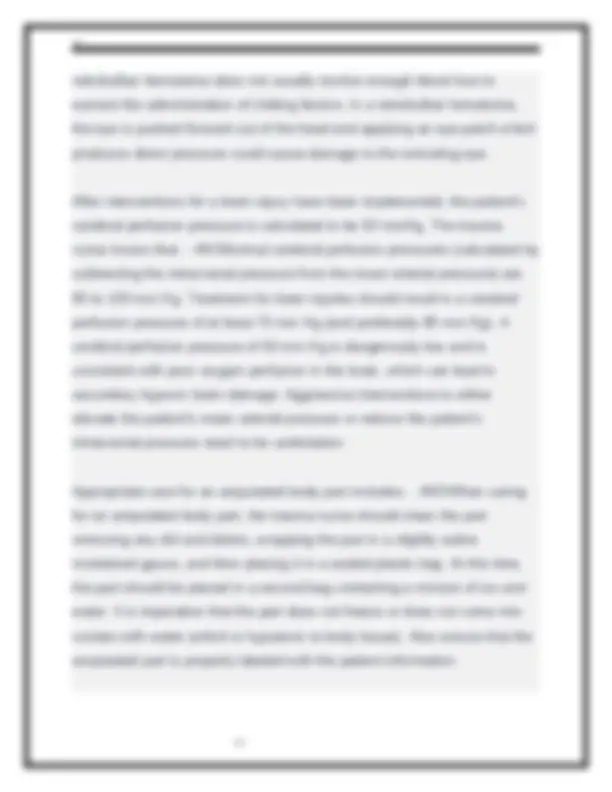
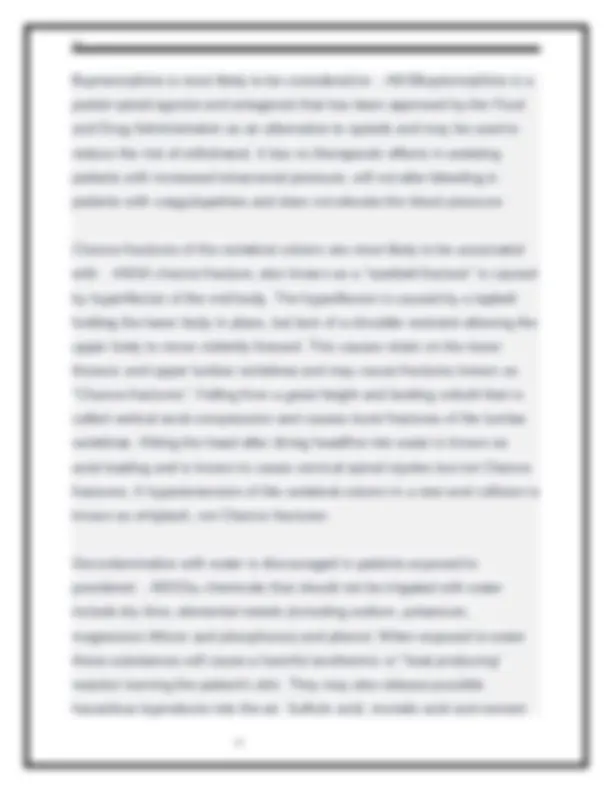
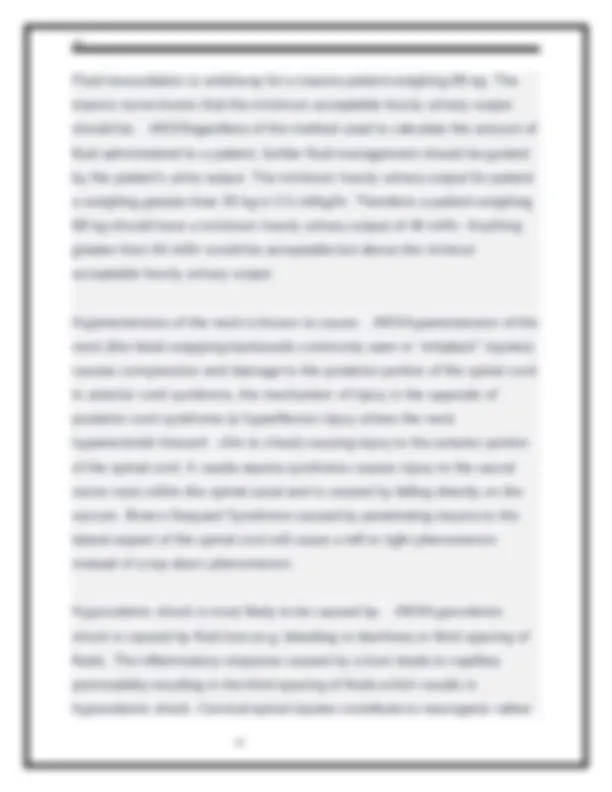
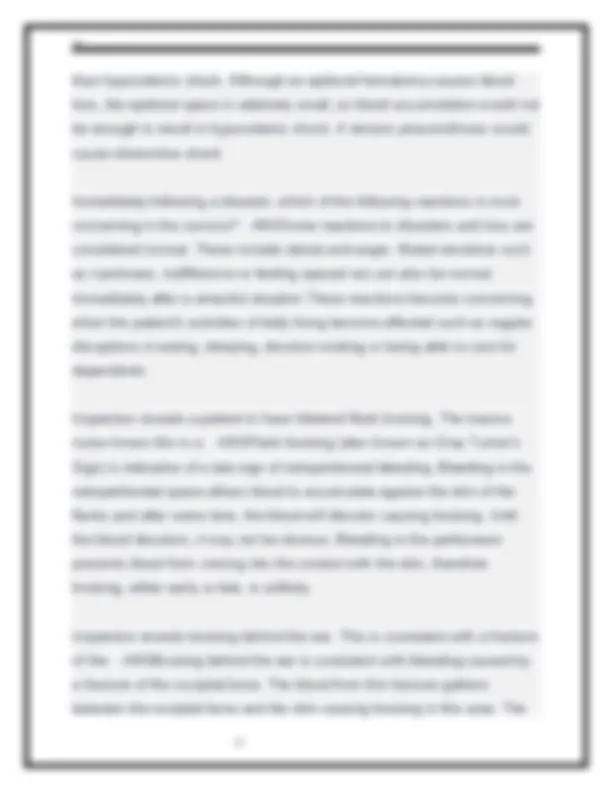
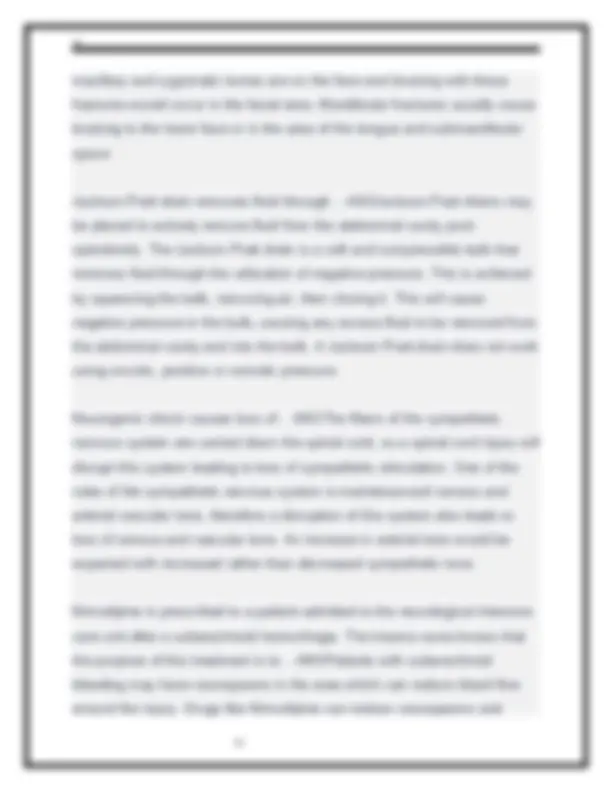
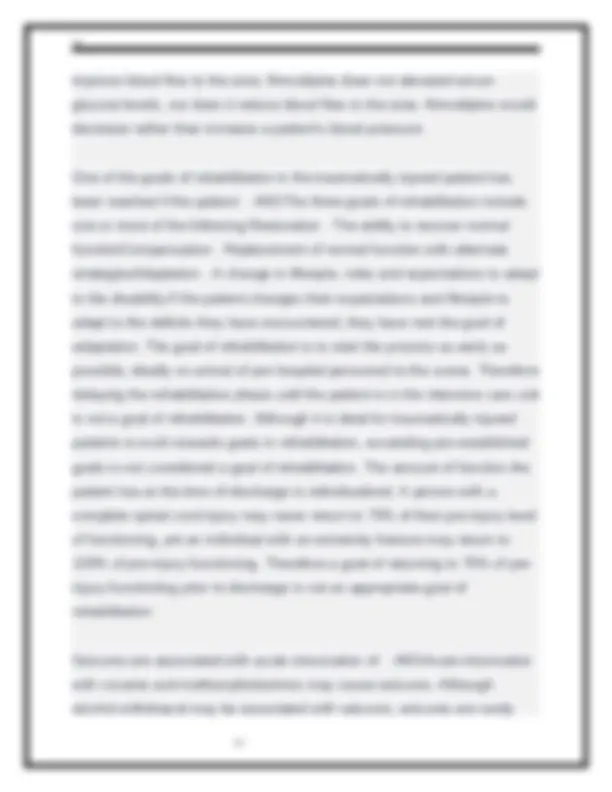
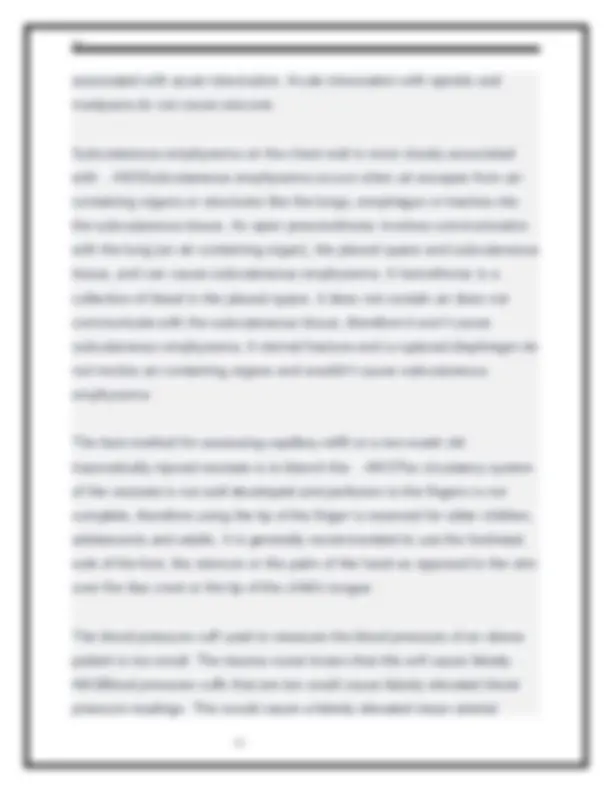
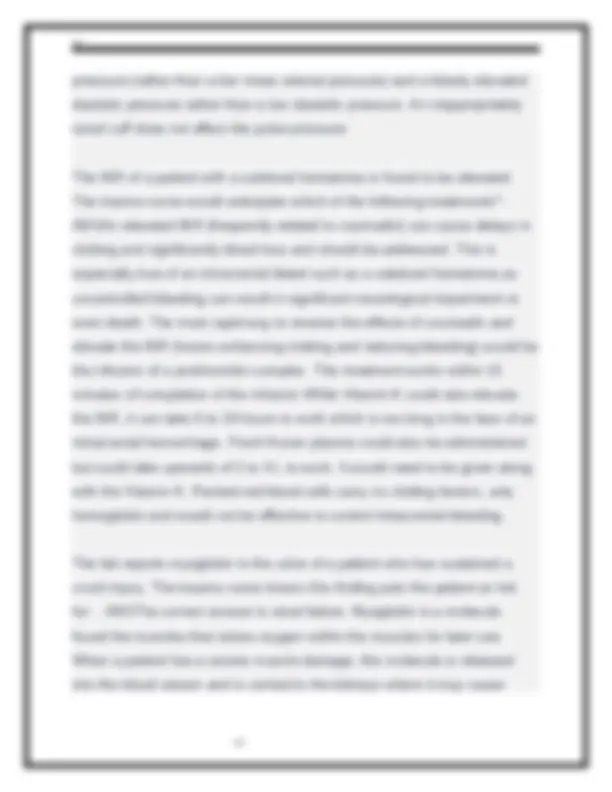

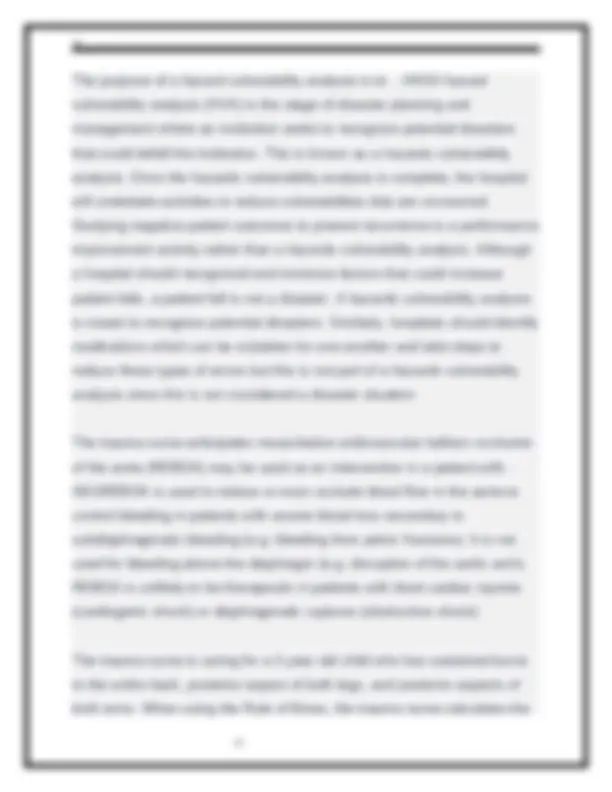

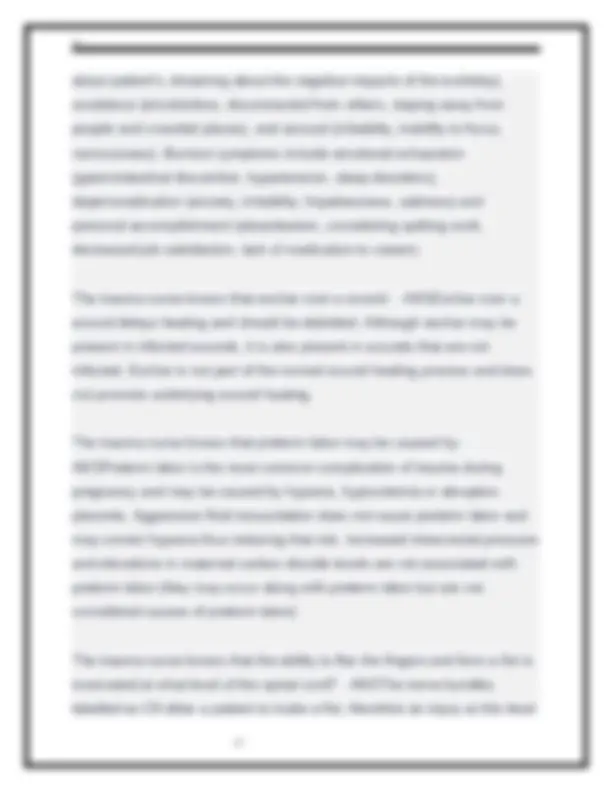

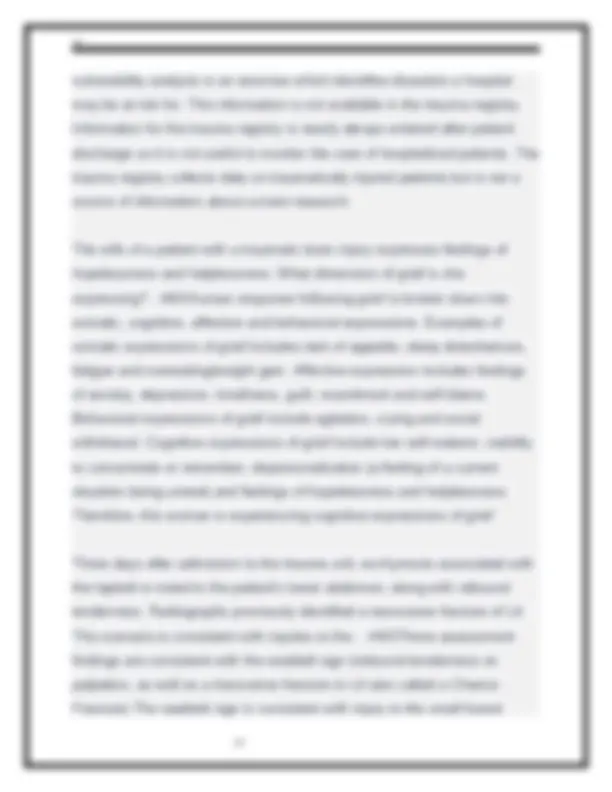
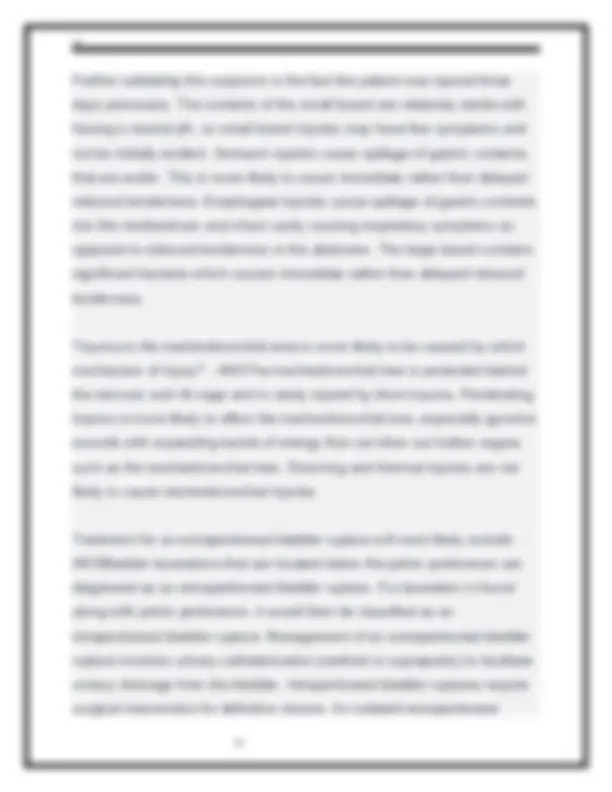
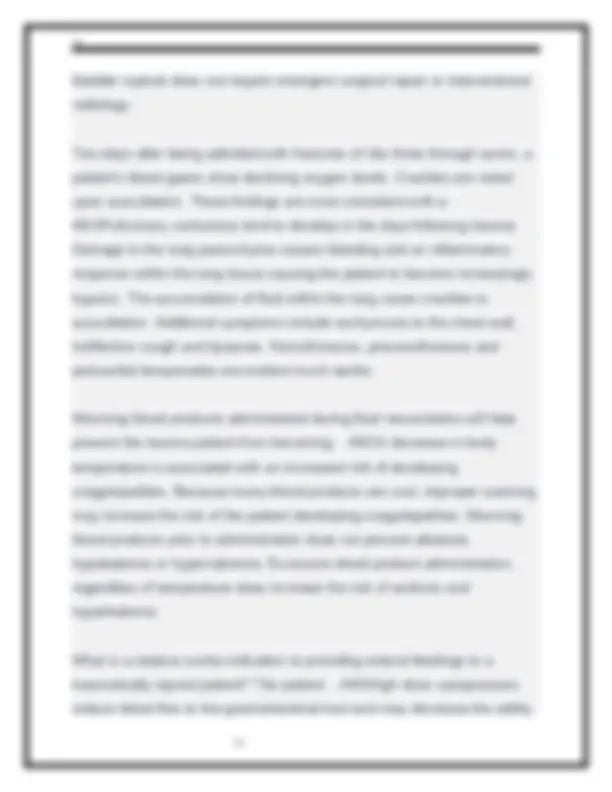
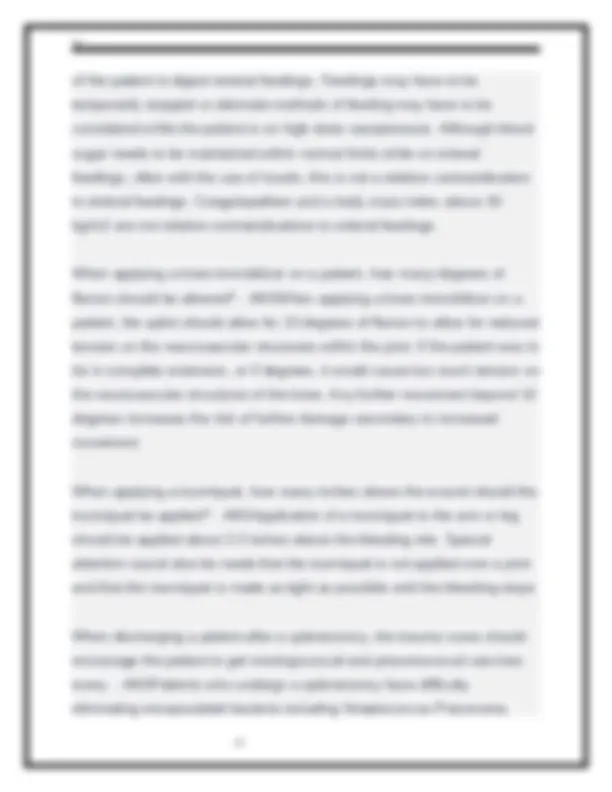
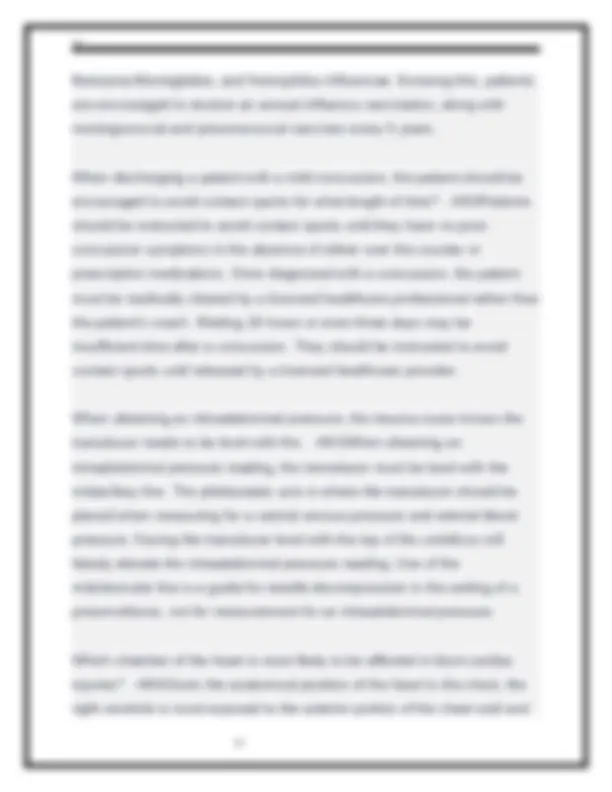
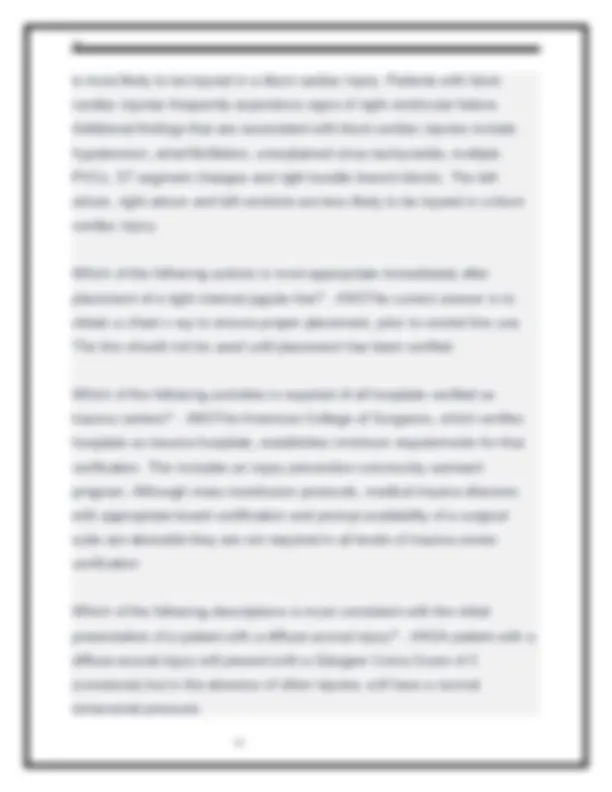
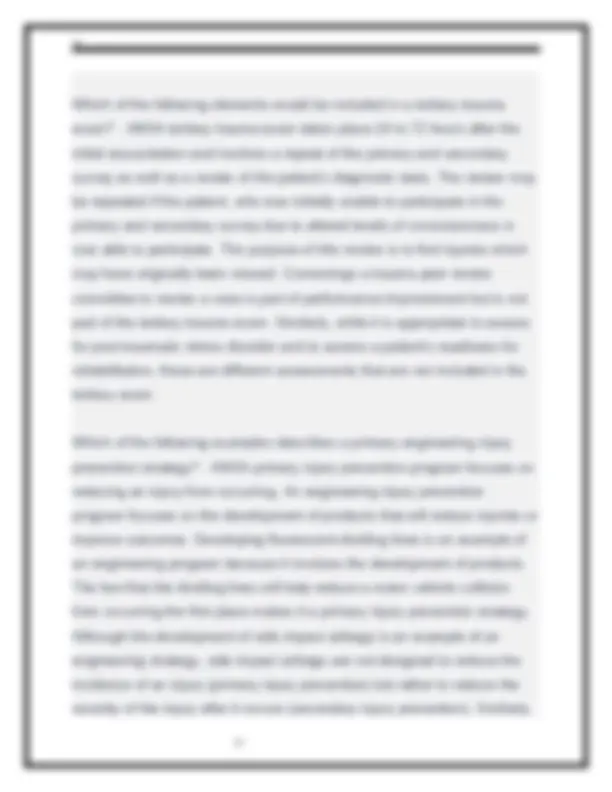
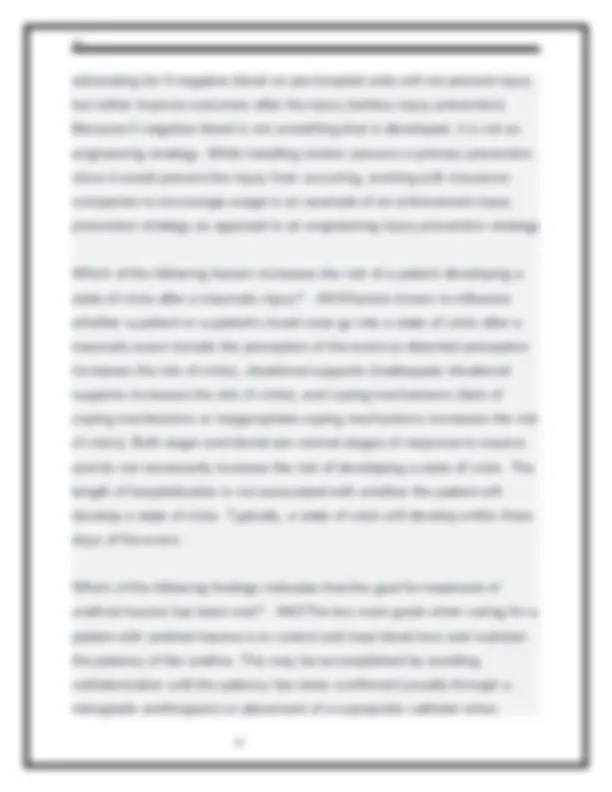
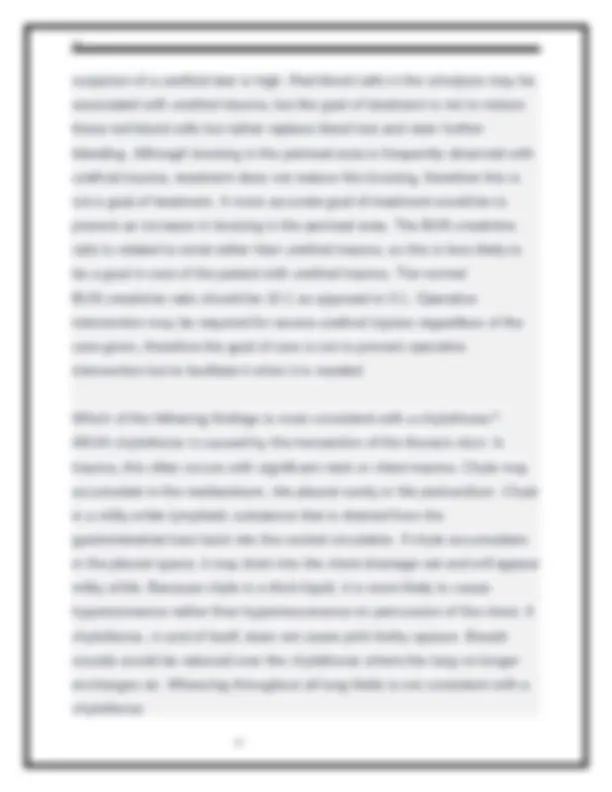
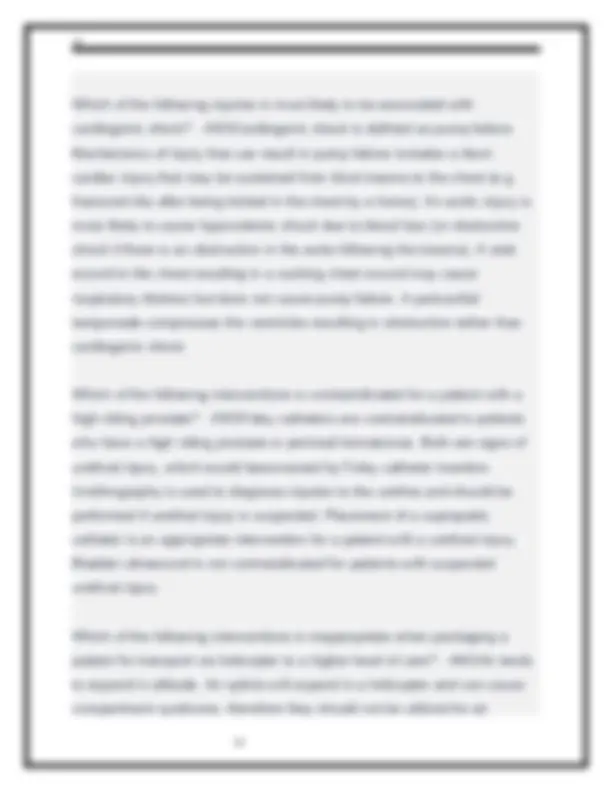
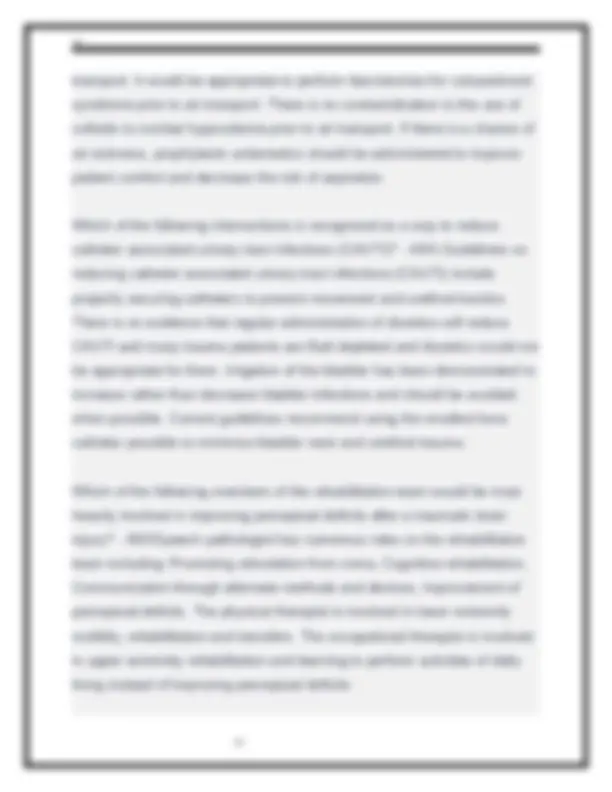
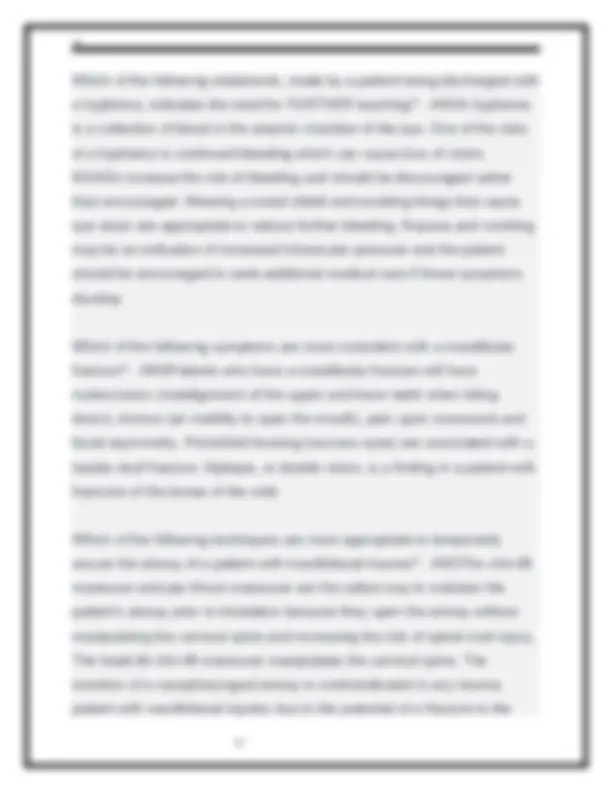
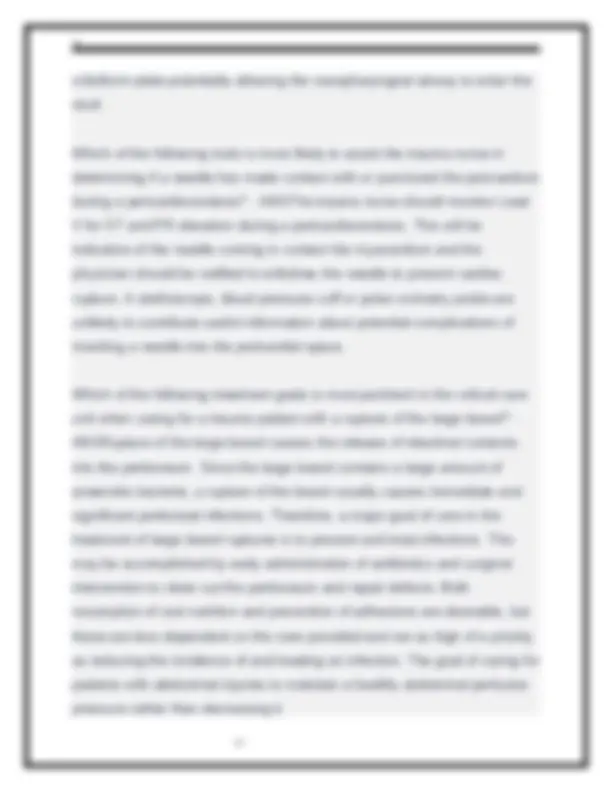


Study with the several resources on Docsity

Earn points by helping other students or get them with a premium plan


Prepare for your exams
Study with the several resources on Docsity

Earn points to download
Earn points by helping other students or get them with a premium plan
Community
Ask the community for help and clear up your study doubts
Discover the best universities in your country according to Docsity users
Free resources
Download our free guides on studying techniques, anxiety management strategies, and thesis advice from Docsity tutors
TCRN Practice Questions with Correct Verified Answers 2025-2026. Graded A
Typology: Exams
1 / 41

This page cannot be seen from the preview
Don't miss anything!


































A 3-year-old is brought to the emergency department refusing to move the left arm after being pulled up vertically by both arms. The trauma nurse suspects that an x-ray will confirm this injury is caused by a subluxation of the: - ANS Nursemaid's elbow is caused when axial traction is placed on a pronated forearm with extension of the elbow. This occurs most frequently in children who are under 5 years of age. When this occurs, a portion of the annular ligament slips off the head of the radius and slides into the radio humeral joint where it becomes trapped causing a dislocation of the radial head A decision is made to withdraw life support and allow a traumatically injured patient to die a natural death. The trauma nurse should inform the family that a symptom commonly encountered near death is: - ANSNumerous symptoms are common at the time of death. In the pulmonary system, these include dyspnea, cough, head/nasal congestion, the "death rattle" and respiratory distress or respiratory depression. Excessive flatus, excitable reflexes and conjunctival hemorrhages are not associated with palliative care and should cause the trauma nurse to look for other causes A diffuse axonal injury is caused by: - ANSA diffuse axonal injury is caused by shearing forces as different areas of the brain slide across each other during a traumatic incident. Blunt forces to the skull are more likely to cause contusions or bleeding. Thermal injury causes burns, and
penetrating trauma causes direct injury to the brain but neither results in a diffuse axonal injury A patient falls from a significant height landing on the buttocks. The patient is incontinent of urine after the injury. This scenario is most consistent with:
A patient has indications of abdominal trauma and is hypotensive, pale and clammy. The abdomen is firm to palpation and tender with reduced bowel sounds. The patient's pulse is 72 beats per minute. The trauma nurse knows that: - ANSPatients who are hypotensive due to hypovolemia are also tachycardic. The pulse may not increase on patients taking beta- blockers, so looking at the medication history may be helpful in determining why the pulse is not increased as expected. A spinal cord injury tends to cause bradycardia; this patient is normocardic. Normally, pulses do decrease with fluid resuscitation but if the patient has a normal pulse due to a beta-blocker, it is unlikely to change with fluid resuscitation A patient is transferred to the trauma center with a basilar skull fracture and is admitted to an inpatient unit. Which of the following symptoms is most likely to develop on the inpatient unit? - ANSOtorrhea (discharge from the ears), rhinorrhea (discharge from the nose), hemotympanum (blood behind the tympanic membrane) and periorbital ecchymosis (accumulation of blood around the eyes) are all symptoms associated with basilar skull fracture. Otorrhea, rhinorrhea and hemotympanum usually occur shortly after the injury whereas blood around the eyes takes time to discolor and become evident so periorbital ecchymosis is the most likely symptom to develop on the inpatient unit A patient presents with petechiae to the face, scalp and neck and a reduced level of consciousness. Strangulation is suspected as the cause of these symptoms. Which of the following symptoms would be consistent with this suspicion? - ANSDamage to blood vessels of the neck during strangulation can lead to neurological deficits such as ptosis, facial droop,
unilateral weakness, loss of sensation, paralysis or seizures). The incidence of gingival bleeding and orbital blowout fractures is not higher in patients who have been strangulated. Clear fluid draining from the ears tends to be associated with basilar skull fractures and strangulation does not increase the risk of this injury. A patient with a sternal fracture is hypotensive and tachycardic with low oxygen saturation. An emergency focused assessment with sonography in trauma (FAST exam) is negative for a cardiac tamponade and the chest radiograph is negative for a pneumothorax. What diagnostic exam will most likely need to be facilitated? - ANSThis patient demonstrates signs of a blunt cardiac injury, often associated with a sternal fracture. The combination of shock symptoms, absence of pneumothorax, and absence of cardiac tamponade indicate that a transthoracic echocardiogram should be performed to determine the presence of a blunt cardiac injury. In the setting of a blunt cardiac injury, further evaluation of the structure of the heart, contractility, and valvular stability needs to be determined rapidly and at the bedside and would be best achieved by a transthoracic echocardiogram. Computerized tomography of the chest, with or without contrast, would be able to evaluate the structure of the heart, but would not be able to adequately assess the blood flow through the heart and valvular integrity and would require a decompensating patient to travel outside of the department. A transesophageal echocardiogram would be beneficial, but this would require time, sedation, and given the patients hemodynamic instability, may be inappropriate.
A primary review of the care of a traumatically injured patient is completed by the trauma program manager and action plans are initiated to address deficiencies noted. In following up, the trauma program manager ensures the corrective action is continuing to have the desired effect through continuous monitoring and evaluation. This process as an example of: - ANSThe final stage of performance improvement is sometimes referred to as "loop closure." This step of performance improvement involves monitoring to ensure that changes recommended in early states of performance improvement have been completed. For example, as part of the performance review process, a new clinical pathway may be devised and even implemented. But performance improvement is not complete until it is determined that this clinical pathway is addressing the deficiencies that led to its initial creation. This requires continued monitoring and evaluation. A clinical pathway is a guideline that may be created to ensure consistency in a process. It often arises out of deficiencies uncovered during review of patient care records. The review of patient care records is known as "secondary review". If the secondary review uncovers deficiencies, then modifications to the process, including as an example, development of a clinical pathway, may be undertaken. So secondary review sometimes leads to the modification phase of performance improvement and one modification that can be considered is a clinical pathway. But these processes must occur first before their effects can be followed to determine if they had their intended improvement (loop closure). A properly applied pelvic binder sits across the: - ANSA properly applied pelvic binder is applied across the greater trochanters of the femur. This allows for optimal compression of the pelvis to control bleeding. Applying it
across the midshaft of the femur is too low and would provide no therapeutic benefit. Applying it across the pelvic ring or the iliac crests is too high and could actually separate the pelvis further, increasing bleeding and internal damage. A properly applied splint for a tibial fracture immobilizes the: - ANSdeally, splints immobilize the joints above and below the fracture. For a tibial fracture, that would include the lower thigh, knee and ankle. If joints on either side of the splint are not immobilized, there is increased movement of the extremity which can exacerbate secondary injuries A ruptured diaphragm causes the greatest disruption to the: - ANSA ruptured diaphragm causes abdominal contents to spill into the thoracic cavity causing compression of the lungs. This negatively impacts the respiratory system. Although the cardiovascular and gastrointestinal system may be affected, they do not cause as great of a disruption as the respiratory system does. The hepatobiliary system is generally not significantly impacted by a ruptured diaphragm A sign of effective resuscitation includes a: - ANSOne of the goals of resuscitation is a core body temperature above 35 C (95F). Temperatures below this are associated with decreased heart rate and cardiac output, increased systemic vascular resistance, decreased urinary output, depressed level of consciousness and decreased coagulation. Normal base levels in the body are -2 to +2. A base excess of +2 is outside of normal limits and may indicate alkalosis. A BUN to creatinine ratio of 1: is associated with fluid deficits and may indicate insufficient fluid
hemorrhage. Metoprolol, Hydralazine and Lisinopril are not calcium channel blockers and would not be effective to prevent and treat vasospasms caused by a subarachnoid hemorrhage A trauma center refers a challenging case to an outside reviewer to validate their review of deficiencies associated with the care of the traumatically injured patient. What type of performance review process is this? - ANSThe first stage of performance improvement is a primary review. The goal at this level of review is to be able to provide immediate feedback and resolution of any deficiencies in care provided. Events that require further investigation will follow into the category of a secondary review and these reviews are done in a step-by-step approach, usually by the trauma medical director or designee. Immediate resolution and feedback can be possible at the end of secondary review, and the issue may be resolved. If the issue is not resolved, it should be referred for a multidisciplinary committee review for further analysis. This type of analysis would be classified as a tertiary review. If further escalation of review is required this would be considered a quaternary review. A quaternary review is either performed by the hospital quality committee, or it is sentfor an external peer review. This type of review is reserved for extraordinary cases or to validate the current trauma hospitalsperformance improvement and patient safety (PIPS)process. A trauma nurse researches the incidence of injuries in a community and decides to implement an education-based secondary injury prevention program. The first educational event is held. What is the next most appropriate step? - ANSAfter implementing an injury prevention program,
the next step is to evaluate its effectiveness before beginning to work on future events. It is essential to determine if the program met its goal. Injury prevention programs are not entered into the data registry. The data registry is designed to collect data on patients that are treated for traumatic injuries. Injury prevention programs do not need to be reported as part of the secondary performance improvement process. Secondary performance improvement involves reviewing a medical record to evaluate the care that is given. Although future injury prevention educational events should be considered, the planning of future events should occur after the current event has been evaluated and modified if the evaluation demonstrates deficiencies. A widened mediastinum is noted on the chest x-ray of a traumatically injured hypotensive patient. The trauma nurse would anticipate gathering which of the following pieces of equipment as the highest priority in this scenario? - ANSA widened mediastinum on chest x-ray, accompanied by hypotension, is strongly indicative of an aortic injury. One of the most life- threatening complications of an aortic injury is blood loss, which can be treated by giving blood products via a rapid transfuser. Although patient assessment may be enhanced by inserting an arterial line, this is less of a priority than giving fluids rapidly. A chest tube is placed in the pleural space rather than the mediastinum and is therefore not indicated in this scenario. Similarly, there is nothing in this scenario that indicates a pericardiocentesis is indicated so this is not a higher priority than preparing a rapid transfuser.
innate right to have their own opinions, perspectives, values and beliefs. Advanced directives allow a patient to make their opinions, perspectives, values or beliefs known either through their own words (e.g. living will) or by asking others to speak on their behalf (e.g. durable power of attorney for healthcare). Veracity is being completely truthful to patients. Advanced directives do not capture this ethical principle. Justice is the equal distribution of healthcare, but this does not describe advanced directives. Beneficence is an ethical principle that states all actions should benefit a patient. Advanced directives are not captured in the ethical principle of beneficence. After an x-ray of the neck, a patient is diagnosed with a spinal cord injury without radiological abnormality (SCIWORA). The trauma nurse should expect the patient will require: - ANSAlthough a spinal cord injury without radiological abnormality (SCIWORA) will not be identified on x-ray or computerized tomography, it will be identified using magnetic resonance imaging. This injury does not require surgery nor will it benefit from the administration of intravenous solumedrol After experiencing a retrobulbar hematoma, a patient's intraocular pressure is measured at 45 mm Hg. Which of the following interventions is most appropriate? - ANSAn intraocular pressure of 45 mm Hg is well above the normal range of 10 - 20 mm Hg. One of the initial interventions for patients with increased intraocular pressure is elevation of the head of the bed. Ketorolac is a non-steroidal anti-inflammatory medication that would not be appropriate for this patient and may increase the risk for further bleeding. Although cryoprecipitate may be used for patients who are bleeding, a
retrobulbar hematoma does not usually involve enough blood loss to warrant the administration of clotting factors. In a retrobulbar hematoma, the eye is pushed forward out of the head and applying an eye patch which produces direct pressure could cause damage to the extruding eye. After interventions for a brain injury have been implemented, the patient's cerebral perfusion pressure is calculated to be 50 mmHg. The trauma nurse knows that: - ANSNormal cerebral perfusion pressures (calculated by subtracting the intracranial pressure from the mean arterial pressure) are 80 to 100 mm Hg. Treatment for brain injuries should result in a cerebral perfusion pressure of at least 70 mm Hg (and preferably 80 mm Hg). A cerebral perfusion pressure of 50 mm Hg is dangerously low and is consistent with poor oxygen perfusion in the brain, which can lead to secondary hypoxic brain damage. Aggressive interventions to either elevate the patient's mean arterial pressure or reduce the patient's intracranial pressure need to be undertaken Appropriate care for an amputated body part includes: - ANSWhen caring for an amputated body part, the trauma nurse should clean the part removing any dirt and debris, wrapping the part in a slightly saline moistened gauze, and then placing it in a sealed plastic bag. At this time, the part should be placed in a second bag containing a mixture of ice and water. It is imperative that the part does not freeze or does not come into contact with water (which is hypotonic to body tissue). Also ensure that the amputated part is properly labeled with the patient information.
can all be irrigated with copious amounts of water (although a much of the dry chemical as possible should be brushed off before irrigation with water is initiated) Despite being alert and oriented, a significant subdural hematoma is noted on a patient's computerized tomography scan. Based on this patient's condition and diagnosis, who would be the primary decision maker should this patient require consent for further treatment? - ANSEven though the patient has been diagnosed with a subdural hematoma, this diagnosis alone does not exclude the patient from making his own medical decisions.Without any subjective or objective neurological deficits, the patient will be able to give direction to staff regarding his wishes for resuscitation and end-of-life care. Therefore the patient remains the primary decision maker, not the son's wife, son or brother. Despite stability after administration of one liter of crystalloids in the resuscitation room, a patient is diagnosed with a grade two liver laceration. The trauma nurse should anticipate which of the following dispositions? - ANSPatients with low grade liver lacerations who are hemodynamically stable are treated nonoperatively with serial abdominal examinations. The patient has the potential to deteriorate rapidly and should not be discharged home. The patient could be transferred to the surgical suite or require further interventional radiology after admission to the inpatient unit if there is a drop in hemoglobin or new onset hemodynamic instability Disaster triage occurs in which of the following stages of disaster management? - ANSResponse stage of disaster management begins after
the disaster has occurred and this is when triaging patients happens. Mitigation and preparedness occur before the disaster occurs. Recovery occurs after the disaster is completed, restoring both damages that occurred to the hospital along with the psychological impact that occurred this to staff members who responds to a disaster. Enteral feedings are initiated on a traumatically injured patient and several days later, the trauma nurse notes a significant elevation in serum blood urea nitrogen (BUN) and creatinine. The trauma nurse should suspect this may be caused by: - ANSOne of the effects of overfeeding the traumatically injured patient is azotemia (elevated BUN and creatinine) and the dietician should be notified of azotemia if it is noted so that an adjustment in calories may be made. Insufficient protein in the diet does not cause azotemia. Although bleeding ulcers may cause elevations in blood urea nitrogen, they do not tend to cause elevations in creatinine. Feeding a patient too quickly after trauma does not cause elevations in BUN and creatinine Fascial compartment pressures are measured at 35mm Hg. The trauma nurse knows this is: - ANSNormal compartment pressures are 10- mmHg. Readings of 30-40 mmHg are significantly elevated indicating there is both ischemia to muscles and nerves requiring emergent intervention. To relieve the pressure in the compartment, a fasciotomy may be performed. There is no pressures considered abnormally low. Pressures between 20 and 30 mm Hg are considered elevated and may be treated with interventions such as elevation of the extremity to the level of the heart, removing ice and compressive dressings and possible diuresis
than hypovolemic shock. Although an epidural hematoma causes blood loss, the epidural space is relatively small, so blood accumulation would not be enough to result in hypovolemic shock. A tension pneumothorax would cause obstructive shock. Immediately following a disaster, which of the following reactions is most concerning in the survivor? - ANSSome reactions to disasters and loss are considered normal. These include denial and anger. Muted emotions such as numbness, indifference or feeling spaced out can also be normal immediately after a stressful situation These reactions become concerning when the patient's activities of daily living become affected such as regular disruptions in eating, sleeping, decision-making or being able to care for dependents Inspection reveals a patient to have bilateral flank bruising. The trauma nurse knows this is a: - ANSFlank bruising (also known as Gray Turner's Sign) is indicative of a late sign of retroperitoneal bleeding. Bleeding in the retroperitoneal space allows blood to accumulate against the skin of the flanks and after some time, the blood will discolor causing bruising. Until the blood discolors, it may not be obvious. Bleeding in the peritoneum prevents blood from coming into the contact with the skin, therefore bruising, either early or late, is unlikely. Inspection reveals bruising behind the ear. This is consistent with a fracture of the: - ANSBruising behind the ear is consistent with bleeding caused by a fracture of the occipital bone. The blood from this fracture gathers between the occipital bone and the skin causing bruising in this area. The
maxillary and zygomatic bones are on the face and bruising with these fractures would occur in the facial area. Mandibular fractures usually cause bruising to the lower face or in the area of the tongue and submandibular space Jackson Pratt drain removes fluid through: - ANSJackson Pratt drains may be placed to actively remove fluid from the abdominal cavity post- operatively. The Jackson Pratt drain is a soft and compressible bulb that removes fluid through the utilization of negative pressure. This is achieved by squeezing the bulb, removing air, then closing it. This will cause negative pressure in the bulb, causing any excess fluid to be removed from the abdominal cavity and into the bulb. A Jackson Pratt drain does not work using oncotic, positive or osmotic pressure. Neurogenic shock causes loss of: - ANSThe fibers of the sympathetic nervous system are carried down the spinal cord, so a spinal cord injury will disrupt this system leading to loss of sympathetic stimulation. One of the roles of the sympathetic nervous system is maintenanceof venous and arterial vascular tone, therefore a disruption of this system also leads to loss of venous and vascular tone. An increase in arterial tone would be expected with increased rather than decreased sympathetic tone Nimodipine is prescribed to a patient admitted to the neurological intensive care unit after a subarachnoid hemorrhage. The trauma nurse knows that the purpose of this treatment is to: - ANSPatients with subarachnoid bleeding may have vasospasms in the area which can reduce blood flow around the injury. Drugs like Nimodipine can reduce vasospasms and